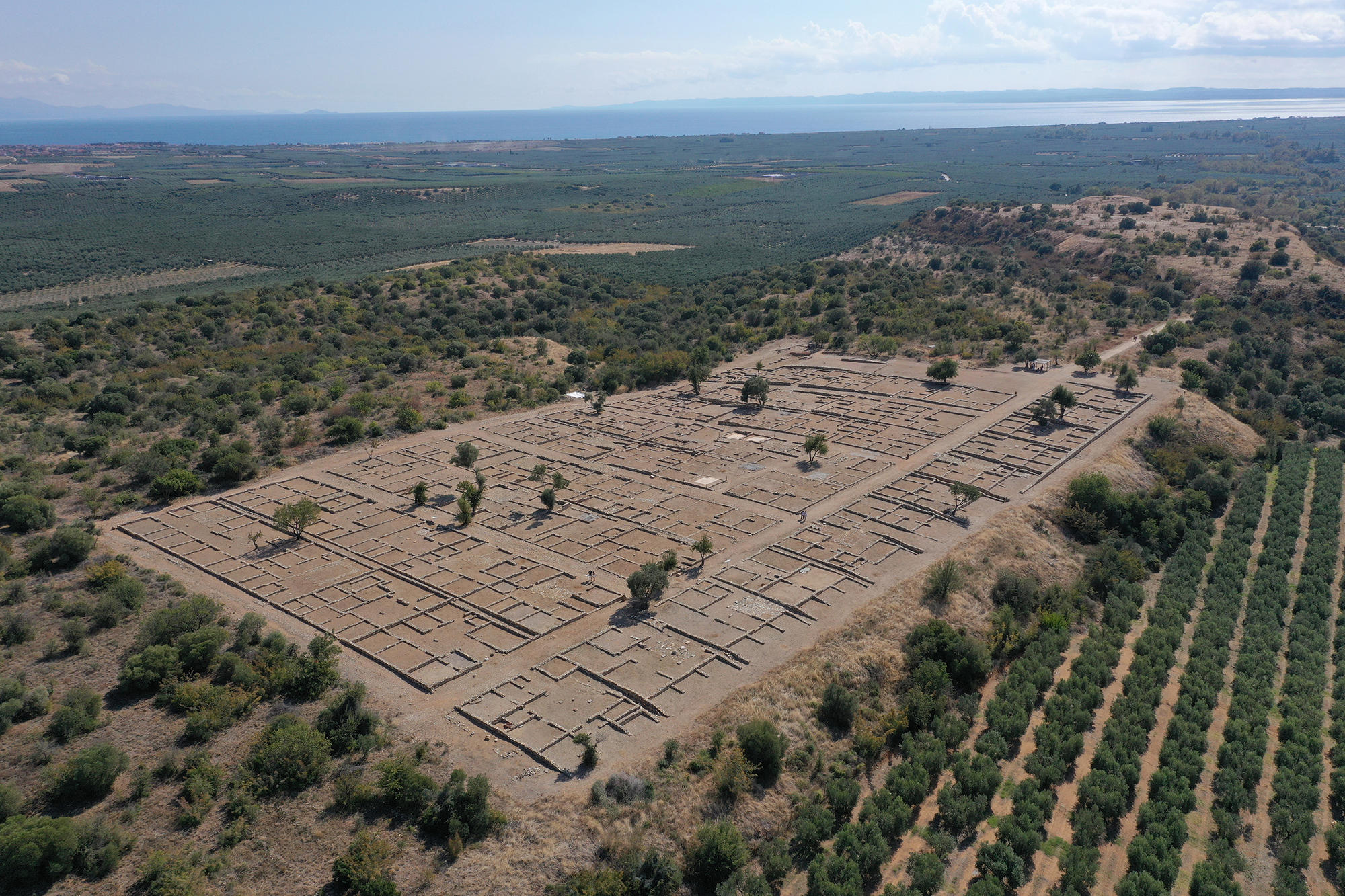
Ancient Olynthus, extending over two natural hills east of the present-day village, evolved into the most important city in Chalkidiki. From 432 BC onwards, when the citizens of many coastal cities settled in the area and Olynthus became the capital of the Chalcidian League, it was a key economic and military center in the region until it was destroyed by Philip II in 348 BC. Thanks to the systematic excavations that revealed a large part of the city, which was built based on the Hippodamian grid plan with an elaborate water supply system, our knowledge of everyday life in the late classical period has been enriched.
The ancient city of Olynthus extends over two natural hills east of the present-day village. There was a settlement of the Late Neolithic period (5300-4500 BC) in the region, one of the first to be excavated in Macedonia that produced significant finds. When the Bottiaeans of Imathia were expelled from their land by the Macedonians in the 7th century BC, they settled on the South Hill and founded the city of Olynthus, whose pre-Greek name derives from the wild fig. This city was destroyed in 479 BC by the Persians, on their return to Asia after their defeat at Plataea. Its inhabitants were massacred and the city was almost entirely destroyed and surrendered to the Chalcidians.
After the Persian Wars, Olynthus became a member of the early Delian League, from which it seceded in 440 BC, to develop into the most populous and wealthy city of Chalkidiki a little later, at the time of its synoecism: in 432 BC, the Macedonian king Perdiccas II convinced the citizens of several seaside cities to abandon the Delian League and settle in Olynthus. The city experienced great prosperity, engaged in commercial activities with Ionia and Athens, and became the capital of the “Chalcidian League”. But the rapid growth of Olynthus brought it into conflict with the Macedonian king Philip II, who could not tolerate another great power in the area; he swept through the city, razed it to the ground after which the city practically disappeared from history.
Excavations at Olynthos under the auspices of the American School of Classical Studies, Johns Hopkins University and under the direction of Professor David M. Robinson, revealed important remains of the city and a large number of finds that provide insight into the daily life and activities of its people. In addition, the “Olynthos Project”, which has been carried out in recent years, in collaboration with the British School of Athens and the Ministry of Culture, aims at a clearer understanding of the entire city, its physiognomy and its special characteristics.
Houses with stone foundations, earthen flooring, brick walls and thatched roofs have been uncovered at the prehistoric settlement of the Neolithic period on the southern part of the hill; a number of finds, such as pottery, stone and clay figurines, as well as weaving tools, provide valuable insight into what daily life was like in the settlement.
Remains of the archaic city were found on the South Hill, where the agora, the bouleuterion, shops and residences were excavated.
The classical city, built based on the Hippodamian system, spreads out on the North Hill: long avenues and smaller vertical streets formed blocks (5-7m wide) consisting of ten houses each. Many of the houses were two-storeyed. The rooms of the house were organized around a central stone-paved courtyard: areas for accommodation and daily household activities, as well as the andron, a banquet hall decorated with mosaic floors in some cases, perhaps the oldest in Greece. The city was laid out with cobbled carriage roads, sidewalks and an integrated water supply system. The newest section extends over the southeastern part of the city, outside the walls; it was built after 379 BC, with luxurious residences, decorated with impressive mosaics. Outside the city, parts of its three cemeteries were excavated, where numerous and significant finds came to light.
References
D.M. Robinson, Excavations at Olynthus (14 τόμοι), Johns Hopkins University Press, Baltimore 1929-1952.
N. Cahill, Household and City Organization at Olynthus (Yale University Press) Yale 2002.
Φ. Αθανασίου – Ε.Μπ. Τσιγαρίδα, Αρχαία Όλυνθος, Αθήνα 2021.
Χειμερινό:
08:30-15:30 1η Νοεμβρίου έως 31 Μαρτίου
Θερινό:
08:30-15:30 1η Απριλίου έως 31 Οκτωβρίου
Κλειστά Τρίτη
Closed on Tuesdays
Με αυτοκίνητο ή με ΚΤΕΛ του
νομού Χαλκιδικής μέχρι την
κοινότητα Ολυμπιάδας.
προβολή σε χάρτη
Τιμή ολόκληρου εισιτηρίου: 4€
Τιμή μειωμένου εισιτηρίου: 2€
Address: Konstantinoupoleos 5,
631 00 Polygyros Halkidiki
Phone: +30 23710 22060
Fax: +30 2310 251892
Mount Athos Technical Office
Address: 7 Hippodrome Square, Thessaloniki
Phone: +30 2310 285163
Fax: +30 2310 251892
E-mail: [email protected]
